Technologies for Effective and Sustainable Use of Geothermal Resources
Introductory Video of Geothermal Energy Team
 "The Earth's Power"
"The Earth's Power"
Technologies for Effective and Sustainable Use of Geothermal Resources
[ YouTube 4'00 ]
Overview
Japan has many volcanoes and a vast amount of geothermal energy. Geothermal energy can contribute to stable power without the effects of weather conditions, and has the potential to cover base load power.
Research Target
The team is conducting research and development on the use of geothermal energy on a suitable scale and in a proper style according to underground conditions and social situations with the following catchphrase: “Proper use of geothermal energy.” In the short term, the team aims to make direct contributions to and increase the amount of sustainable power generation by developing a monitoring system for the coexistence of hot springs and geothermal power generation, and to perform advanced monitoring of the change in the reservoirs.
Furthermore, in the long term, the team will make geothermal energy available on a large scale as a base load power source by developing innovative power generation technologies through the use of supercritical geothermal resources originating from the subduction zone and derive methods for using geothermal energy in society.
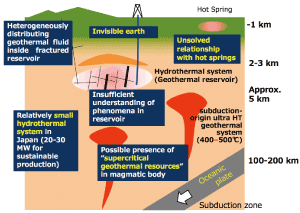 【Fig. 1】Need for studying and developing geothermal energy
【Fig. 1】Need for studying and developing geothermal energy
*Click to enlarge
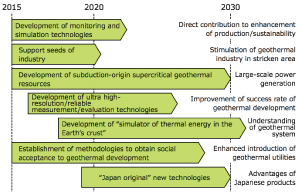 【Fig. 2】FREA’s Geothermal Energy Research Roadmap
【Fig. 2】FREA’s Geothermal Energy Research Roadmap
*Click to enlarge
Research Outline
The team is conducting various projects funded by the government and private sectors under the concept of “proper use of geothermal energy”. Basic studies in geoscience to deepen the understanding of geothermal systems are also being carried out.
Because geothermal systems at depth are invisible and they are typical Thermal-Hydro-Mechanical-Chemical ( THMC) coupled systems, the development of monitoring technologies, simulators and the collection/analysis of field data are important.
The goals of the main research activities of the team are as follows:
- Investigate the feasibility of power generation using subduction-origin supercritical geothermal systems and establish technologies/materials for commercial power generation by around 2050.
- Develop technologies for the creation and control of geothermal reservoirs through laboratory tests and studies of numerical simulators. Methodologies for the universal development of geothermal resources and their sustainable utilization.
- Understand and visualize various phenomena inside geothermal systems through the development of advanced analysis techniques of seismic and electromagnetic signals and high performance monitoring/sensing systems.
- Develop a monitoring system of hot springs for coexistence of hot springs and geothermal power generation by introducing AI and IoT technologies.
- Contribute to the promotion of the geothermal industry in area stricken by the 2011 Earthquake by supporting the commercialization of technological seeds in industry.
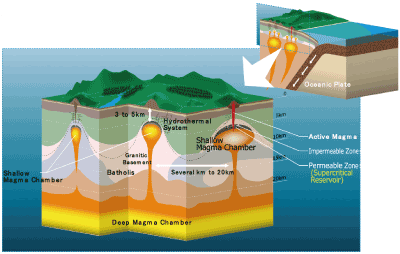
【Fig. 3】
※Researchers in the team led a group of Japanese geothermal researchers and demonstrated the feasibility of power generation from several GW to a total of 100s of GW from subduction-origin supercritical geothermal resources. National projects for commercial power generation using supercritical geothermal resources around 2050 are underway.
In order to prevent a decrease in steam/hot water production which, after 20 years of production, has occurred at Okuaizu Geothermal Field in Fukushima since 2015, the Geothermal Team deployed a dense and high-performance surface/downhole microseismic monitoring network, and analyzed the collected data by applying the most advanced seismic signal processing/imaging techniques. The team will contribute to the establishment of methods of injecting treated water into the reservoir to maintain the sustainability of geothermal resources.
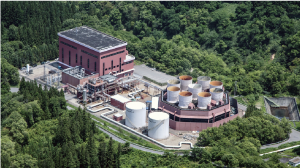 【Fig. 4】Yanaizu-Nishiyama Geothermal Power Plant
【Fig. 4】Yanaizu-Nishiyama Geothermal Power Plant
(Photo courtesy of Tohoku Electric Power Co., Inc.)
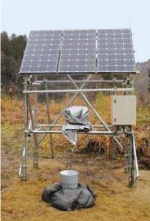 【Fig. 5】Installation status of three component seismometers
【Fig. 5】Installation status of three component seismometers
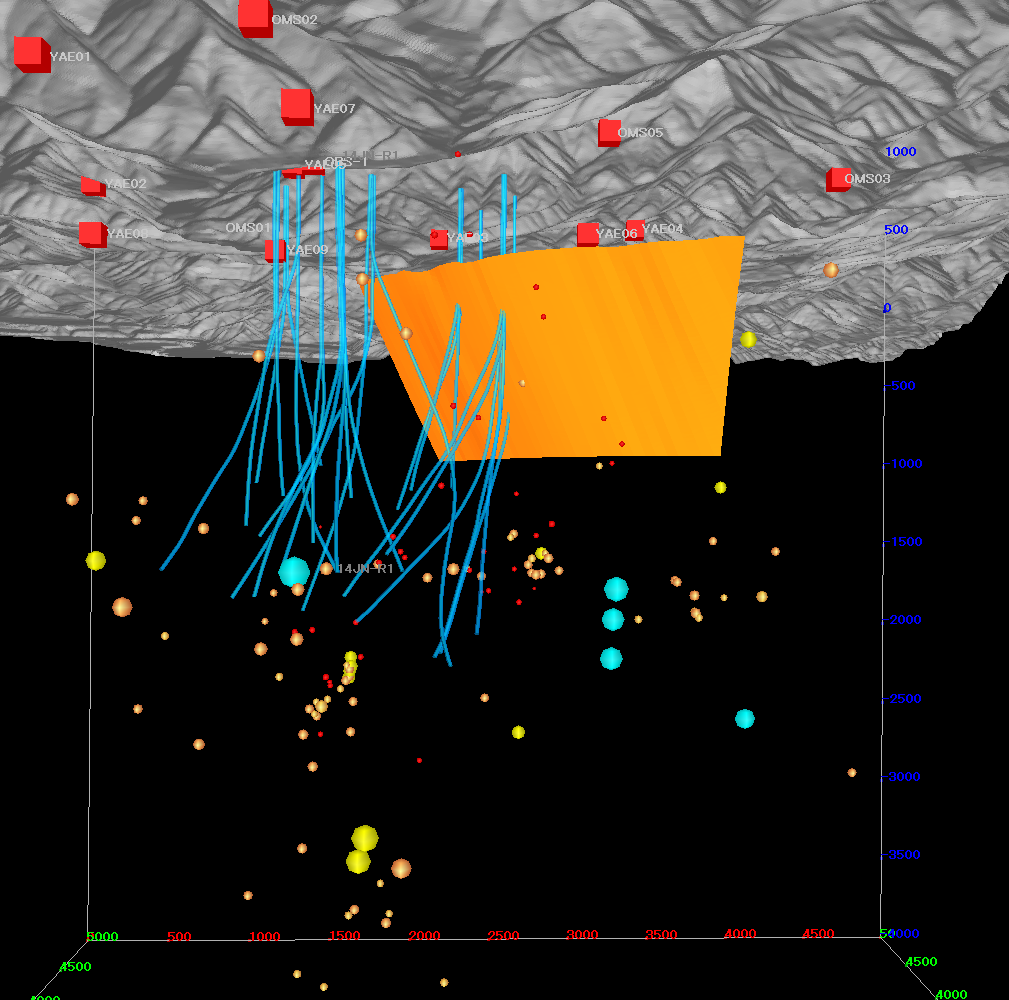 【Fig. 6】Microearthquake data integration and visualization system
【Fig. 6】Microearthquake data integration and visualization system
*Click to enlarge
Main Research Facilities
【Fig. 7】Examination device for hot spring system
The device simulates a hot spring pipeline in the laboratory for evaluating hot spring monitoring sensors and conducting experiments on hot spring.
【Fig. 8】Experimental facility for shear slip of a fracture
This facility enables the simulation of various mechanical phenomena in geothermal reservoirs under high temperature and pressure.
【Fig. 9】Experimental facility for the development of borehole tools for high-temperature and high-pressure geothermal wells
This facility is capable of simulating 350°C, 60 MPa borehole conditions.
Activities and Achievements
Development of supercritical geothermal resources
As a principal research team of the national project, the team collected geological information and conducted exploration, and revealed the characteristics of supercritical geothermal systems in several points in Japan. The feasibility of commercial power generation using supercritical geothermal resources has also been demonstrated.
Advanced microseismic monitoring of geothermal reservoirs
Estimation of hypocentral locations, imaging of scattering and reflectivity around/inside the seismogenic zones was carried out using the newest technologies and the behavior of water injected into the reservoirs has been estimated.
Development of simulators of artificially created reservoir
Simulators of creation and production of Enhanced Geothermal System (EGS)-type reservoirs have been developed.
Development of monitoring system for hot springs
The team developed hardware for the remote and continuous monitoring of hot springs and techniques for processing collected data using AI in collaboration with private companies.
Seeds supporting program from local industry
The team supported the commercialization of technological seeds of local industries under the “Supporting Program of Seeds of Stricken Area” scheme of the FREA.
Performance of downhole tools for geothermal wells, a simulator of geothermal reservoirs, a binary power generation system for hot springs, and a hydrogen generation system for hot springs have improved throughout this project and commercialization is expected in the near future.
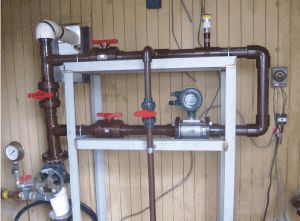 【Fig. 10】Remote monitoring system of hot springs
【Fig. 10】Remote monitoring system of hot springs
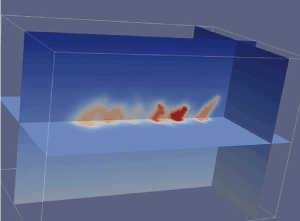 【Fig. 11】Simulator of EGS
【Fig. 11】Simulator of EGS
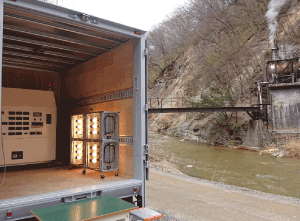 【Fig. 12】Mobile binary power generation system for hot springs
【Fig. 12】Mobile binary power generation system for hot springs
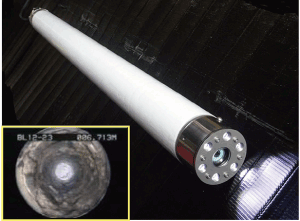 【Fig. 13】 Borehole scanner for geothermal/hot spring wells developed through “Seeds Supporting Program
【Fig. 13】 Borehole scanner for geothermal/hot spring wells developed through “Seeds Supporting Program
Team Member
| Title |
Name |
| Leader |
YAMAYA Yusuke |
| Senior Researcher |
ISHIBASHI Takuya |
| Senior Researcher |
WATANABE Norihiro |
| Senior Researcher |
OKAMOTO Kyosuke |
| Researcher |
SUZUKI Yota |
| - |
YANAGISAWA Norio |
| - |
SAISHU Hanae |